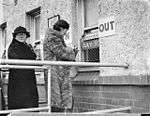Victoria Park Racecourse, Sydney
- For the park in Camperdown, Sydney, see Victoria Park, Sydney
Coordinates: 33°54′29″S 151°12′38″E / 33.908°S 151.2105°E Victoria Park Racecourse was a racecourse in Zetland, an inner-city suburb, south of Sydney, New South Wales, Australia. It was bordered by O’Dea Avenue, South Dowling Street, Epsom Road and Joynton Avenue.
The site was originally a lagoon and swamp which was drained in the early 1900s to create the racecourse.[1] The racecourse was privately owned and developed by Sir James John Joynton Smith (1858–1943), a hotelier, racecourse and newspaper owner.[2] It was said at the time to be the grandest and finest of the pony horseracing courses in Sydney.
In 1908 a clay-and-cinders track of 1.81 kilometres in length was built around the horseracing course and was utilised for speedway racing by both cars and motorcycles until the early 1920s.[3]
In 1909 the first powered flight in Australia took place here in a Wright model A plane named "The Stella". The pilot was Colin Defries although only flying 120 yards at 15 feet it is acknowledged by Australian historians[6] and the Aviation Historical Society of Australia that the definition of flight established by the Gorell Committee on behalf of the Aero Club of Great Britain dictates the acceptance of a flight or its rejection, giving Colin Defries credit as the first to make an aeroplane flight. A 20-page booklet entitled The History of Aviation Souvenir Australian Tour by Ambrose Pratt under direction of J &N Tait 6d price was issued at the time. It shows pictures of the pilot & the plane and also a seated passenger with caption preparing to fly.
During World War II the site was used for an aircraft factory.[3] In 1945 it reopened as a horse training course.[4]
The racecourse was bought by British businessman Lord Nuffield in 1947 and from 1950 the site was utilised by Nuffield Australia for a motor vehicle assembly facility.[5] Vehicle production was continued by Nuffield Australia and its successors BMC Australia and Leyland Australia [6] until the factory was closed in 1975.[7]
The site was acquired by the Commonwealth of Australia for a Naval Stores depot which operated until the mid-1990s. The site is currently undergoing redevelopment into high density housing. A three-storey totalisator building remains on the site, used as a site office by the redevelopers and now part of the complex.[8] The racecourse is also remembered in Tote Park, a small park on the site.

References
- ↑ Weirick, J.Watering Sydney. Architecture Australia, accessed 13 January 2008.
- ↑ Smith, Sir James John Joynton (1858 - 1943) Australian Dictionary of Biography, Online Edition. Accessed 13 January 2008.
- 1 2 The Macquarie Dictionary of Motoring, 1986, page 517
- ↑ Anderson (ed.), Barry (2012). Building Cars in Australia. Halstead Press. p. 20. ISBN 9781920831912.
- ↑ BMC-Leyland Australia Heritage Group, Building Cars in Australia, 2012, page 21
- ↑ BMC-Leyland Australia Heritage Group, Building Cars in Australia, 2012, page 176
- ↑ BMC-Leyland Australia Heritage Group, Building Cars in Australia, 2012, page 166
- ↑ Peake, W. Unregistered Proprietary Horseracing in Sydney, 1888-1942 University of Western Sydney, December 2004.